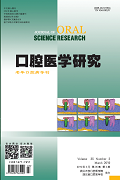|
|
Influence Factor on Prognosis of the Elderly with Oral Squamous Cell Carcinoma in Fujian Area
WU Jun-feng, SHI Bin, CAO Yu-jie, CHEN Fa, CAO Rong-kai, ZHANG Shi-lei, HUANG Yue
2019, 35(3):
242-245.
DOI: 10.13701/j.cnki.kqyxyj.2019.03.012
Objective: To explore the influence factor on prognosis of the elderly with oral squamous cell carcinoma (OSCC) in Fujian area. Methods: From January 2004 to Jan 2018, a total of 288 elderly patients with pathologically confirmed OSCC were recruited in a hospital of Fujian. The clinical and follow-up data of all patients were collected to explore the influence factor on prognosis of the elderly with OSCC. Survival rate and cumulative incidence were calculated using the Kaplan-Meier method and the cumulative risk model. The differences of two groups were compared by Log rank and Gray test. The Cox proportional hazards regression model and the Fine-Gray model were performed to estimate the prognosis factors among elderly OSCC patients. It was also stratified by BMI to assess the association between treatments and the prognosis of the elderly with OSCC. Results: The Cox proportional hazards regression model indicated that preoperative dentures (HR=1.74,95%CI:1.11,2.71); T3-4 stage (HR=3.64,95%CI:1.32,10.01); N1 and N2-3 (HR=2.78, 95%CI:1.36,5.64) and (HR=1.96, 95%CI: 1.01,3.80); poor differentiation (HR=2.25, 95%CI: 1.27,3.99). The Fine-Gray regression model indicated that the female (SHR=0.58, 95%CI: 0.36,0.94); N1 and N2-3 (SHR=2.29, 95%CI: 1.29,4.05) and (SHR=4.42, 95%CI: 2.48,7.85); M1 stage (SHR=2.977, 95%CI: 1.08,8.20); surgery combined chemoradiotherapy (SHR=2.14, 95%CI: 1.26, 3.65). The stratification analysis demonstrated that surgery combined with radiotherapy increased the risk among BMI <18.5 elderly OSCC patients. Conclusion: Preoperative dentures, T stage, N stage, M stage, histologic grade, and treatment are risk factors for elderly OSCC.
References |
Related Articles |
Metrics
|

